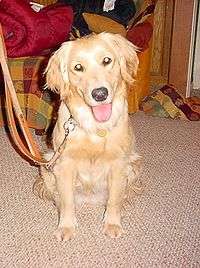Leader Dogs for the Blind
Leader Dogs for the Blind is a guide dog training school located in Rochester Hills, Michigan. It was founded in 1939 by Lions Club members, Charles Nutting, Don Schuur and S.A. Dodge,[1] as the second guide dog school founded in the United States and has paired over 14,000 dogs with the visually impaired worldwide, making it one of the largest organizations of its kind.
| Non-profit | |
| Industry | Guide dog training |
| Founded | 1938 |
| Founder | Uptown Detroit Lions Club |
| Headquarters | , United States |
Key people | Susan Daniels, President & CEO |
| Revenue | 16,629,630 US dollar (2017) |
| Website | www |
Much like "seeing-eye dogs" from The Seeing Eye, Leader Dogs's trained canines are called "leader dogs."
Leader Dogs is a nonprofit organization. All expenses, including room and board, airfare, and the dog itself, are offered free of charge. An Applicant, after being accepted into the program, travels to Leader Dogs headquarters and must spend from nineteen to twenty-six days of training with his or her new dog, after which the dog belongs to the applicant officially.

Leader Dogs employs a breeding program to supply dogs, consisting mostly of pure bred Labrador and Golden Retrievers and German Shepherd Dogs. Dogs donated from the general public and animal shelters, who are of fitting physical and mental character, are also sometimes accepted. Additionally, through a partnership with service and hearing dog organization Paws With A Cause, dogs unsuited for the work of their respective programs may be "career changed" to another program.
History
In the summer of 1938, the Uptown Detroit Lions Club members gathered to discuss the future of Dr. Glenn Wheeler, a blind man who had shown interest in obtaining a personal guide dog. They decided to pay all of the expenses for the man and contacted the only school in America at the time for guide dogs, The Seeing Eye. The club was turned down because of the schools policy, which stated that individuals could not be sponsored by clubs or organizations, but that the contributions must go into the school as a whole, to be used where needed. This was an initial setback.
However, the Lions Club members did find individual trainers of dogs, one in particular named Glen Staines, who trained Doberman Pinchers. He was hired on October 6, 1938 to train as many as four dogs for a price of eight hundred dollars. If students could not be found, then the agreement would be terminated, and the Lions Club would have to keep two of the dogs. They did find four students: Dr. Wheeler, Earl Morrey, William Joyce, and Paul Brown. After hearing about the cause, the Park Avenue Hotel in downtown Detroit offered free accommodations for the students learning to handle their dogs. Soon the club needed a name for their mounting project. They had dogs, a trainer, students, and a place to house these students, something they had not even imagined.
To find a suitable name, a four-page report was sent out to every single member of Lions International. Over 500 names were sent back as suggestions. "Lions Leader" was the name selected, and printed in the newspapers on December 14, 1938. In February 1939, all four Doberman Pinchers were placed with their new owners. The club wanted to expand their help beyond the actual club, and on April 4, 1939 the "Lion's Leader Dog Foundation" was initiated. To get the new school off the ground, an actual facility was needed. A small farm in Rochester Hills, Michigan was selected. On the property were a house, a barn, and a small garage, which were all rented for fifty dollars a month.
The name was changed to "Leader Dog League for the Blind" in 1940, and during the first year eighteen dogs were placed with blind students. Despite many hardships, the school stayed open and was helped tremendously by the number of blind veterans returning from World War II. The blind were requesting dogs for their new lives and businesses began to hire the blind, as it was discovered that many blind could carry on normal jobs. The United States government eventually promised federal funds to all guide dog schools and these schools began to pop up everywhere around the country. To date, Leader Dogs for the Blind has paired over 14,000 dogs with the visually impaired and continues to serve clients around the world.
See also
- List of Guide Dog Schools
References
- Leader Dogs for the Blind: About Us Archived 2006-06-27 at the Wayback Machine
2. Gibbs, Margaret. Leader Dogs for the Blind. Faifax, VA: Denlinger's Publishers, 1982.